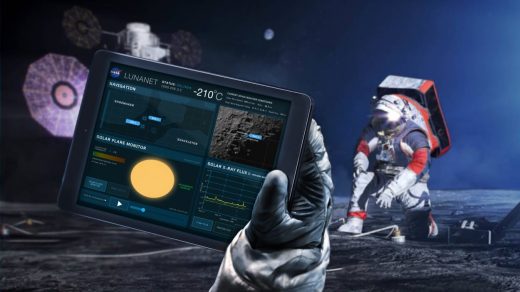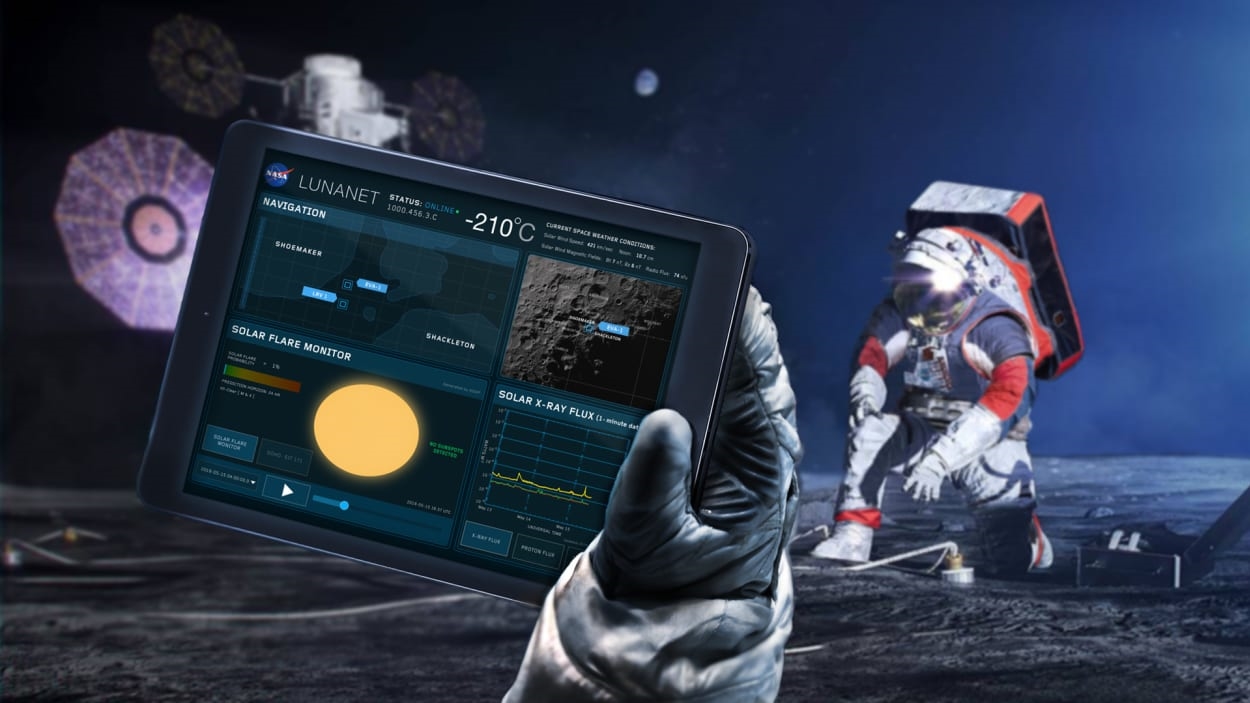Inside NASA’s big plan to bring the internet to the moon
By Rebecca Heilweil
Humanity is going back to the moon—and this time we’re bringing the internet.
Last year, NASA launched Artemis 1, the first in a series of missions that aim to return American astronauts on the lunar surface, and, eventually, establish a permanent U.S. base camp. Now, the agency is preparing for an equally important objective: making sure that when future astronauts do finally land on the moon, they’ll be able to post a selfie.
The U.S. space agency is in the early stages of developing LunaNet, a nascent but critical plan to build an internet network for the moon. Of course, the effort is about far more than just allowing astronauts to snap a few selfies. Compared to the historic Apollo missions, which focused on bringing humans to the moon for the first time, the Artemis program has loftier goals. NASA is planning to construct a wide range of infrastructure on and around the moon, including a human habitat, a new space station, and a lunar web service that can keep everything connected.
“On Earth now, we also have all the cellphone towers and WiFi hotspots and things to give us network connectivity, and that really changed the way that we go about our daily lives,” says Dave Israel, a principal investigator and division architect at the NASA Goddard Space Flight Center. “What we want to do is make that experience possible for the astronauts and robotic missions that are going to the moon, and then—in the future—to extend it up to Mars and wherever we’re going to go.”
There are challenges, though. Transmitting data between Earth and the moon isn’t exactly easy, particularly from the lunar south pole and the far side of the moon, which doesn’t directly face Earth. Transport presents another hurdle: Trips to the moon aren’t too frequent, so actually transporting the lunar internet equipment may take quite some time. Several upcoming launches— including the crewed Artemis II mission currently scheduled for 2024—will involve demonstrations of moon communications technology. Still, Israel says he doesn’t anticipate things getting fully up and running until later this decade.
One big step for space internet
Here on Earth, we’ve used satellites in our orbit to connect the web (especially on planes) for years. And companies like SpaceX, OneWeb, and Amazon are currently in the process of building out networks of thousands of satellites in low-Earth orbit to provide even faster service from space. The International Space Station is also hooked up to the web. Unfortunately, the same can’t be said about the moon.
“The data rates that customers are currently getting on the moon on is like dial-up—it’s not even like dial-up—it’s like dial-up you’re fighting to get access to,” explains Kelly Larson, the CEO of Aquarian Space, a startup that focuses on lunar communications.
To improve service, NASA is planning to launch lunar satellites that will connect with each other, and then back to communications infrastructure on Earth. Relay spacecraft will be particularly helpful for the harder-to-reach areas of the moon, like the far side and the lunar south pole, which the space agency is hoping astronauts will eventually explore. NASA will also deploy a series of ground stations, which will essentially work like cell towers, on the lunar surface. In theory, lunar communications will work less like a phone line and more like an internet network.
Private companies have a role to play in building this new internet infrastructure. Aquarian Space, for example, is planning to launch its first lunar communications satellites in the second quarter of 2025, and eventually hopes its tech will eventually offer a 100 megabit-per-second, 24-7 lunar surface. NASA is also working with Nokia to build a 4G cellular network for the moon. The company has already won a more than $14 million contract from the space agency, and its first base station—along with radio equipment—should be delivered to the moon via a SpaceX rocket scheduled to launch sometime next year.
“It doesn’t look that different to us compared to a mine or a rig or a remote wind farm or a factory,” explains Thierry Klein, the president of Bell Labs Solutions Research at Nokia Bell Labs. “It just happens to be very far away. It just happens to be very harsh. But from a communication perspective, it just looks like the extreme version of what we do every day.”
The European Space Agency is working on a parallel project, called Moonlight, which aims to recruit companies to build lunar telecoms infrastructure, too.
Much of the motivation behind the moonshot internet service is actually about basic logistics. As human visitors and robots start trekking across the surface of the moon in greater numbers, they’ll need a communications network to help them with directions—somewhat like the global positioning system (GPS) we use here on Earth. The future LunaNet may also play a role in keeping a standard time on the moon, which will be critical to scheduling activities on the moon’s surface and in lunar orbit. The web service could also help monitor astronauts’ health and track the equivalent of lunar weather, explains Israel.
“We’re planning and expecting to see lots of high data rate video coming back from the moon, and for those of us on Earth to really be able to experience along with the astronauts when when they’re there,” he says.
NASA is hoping that the network will expand as activity on and around the moon grows. The agency expects that with the arrival of Lunar Gateway, its new lunar space station, the moon will need about 210 megabits per second and 4.6 terabytes per day, according to a slideshow created by the space agency last year. By 2035, or around when NASA anticipates gearing up for a human mission to Mars, the moon may need as much as 950 megabits per second and 12 terabytes a day.
Even in the short term, demand for lunar internet is expected to rise. There were only 13 assets, including several lunar landers and rovers, on and around the moon in 2021, according to Aquarian Space. The company says that projections show that by the end of the decade, there may be between 200 and 250.
Sky-high geopolitical stakes
Whoever shapes the internet on the moon will hold a remarkable amount of power, from dictating how network providers work together to handing out lunar web addresses. While the U.S. is racing to corral other countries and space agencies under the umbrella of its Artemis Accords—a set of international principles meant to guide exploration and development of the moon and outer space—there’s no guarantee that everyone will sign on. Notably, Russia and China are collaborating on their own lunar projects.
“The moon is the eighth continent for Earth. It will matter which country is able to offer internet capabilities that can address the needs of a diversity of actors that are planning on getting to the moon in the next decade,” says Namrata Goswami, a space policy expert and author of Scramble for the Skies: The Great Power Competition to Control the Resources of Outer Space. “The country that will be able to offer the most cost-effective lunar internet package will win the race.”
Of course, it might be a while before the lunar internet seems that pivotal, especially in our daily lives. At least in the beginning, much of the network will facilitate communications between robots and professional astronauts, and will primarily assist missions taking place hundreds of thousands of miles from Earth. In many ways, this major expansion of the web will initially be invisible, and limited to a few government agencies and companies.
But that doesn’t bother the people working on LunaNet. They’re hoping that the future of moon internet will mirror the story of the original web, which got its start in the 1960s as a way to send information between a network of computers. At the time, no one was thinking about Facebook and Uber, but it was that decades-old core technology that eventually enabled these services, which, in turn, changed the world. People like Israel, the investigator from NASA, believe their work will similarly serve as a technical foundation for the moon, and, eventually, the rest of the solar system.
“Taking a selfie, and then saying, ‘Hey, check it out, here’s me on the moon,’ and clicking send,” he says. “I’m part of making that happen.”
(32)



